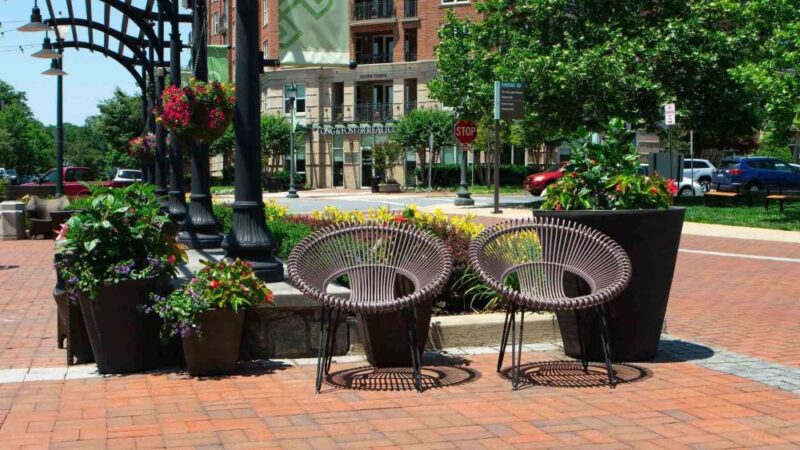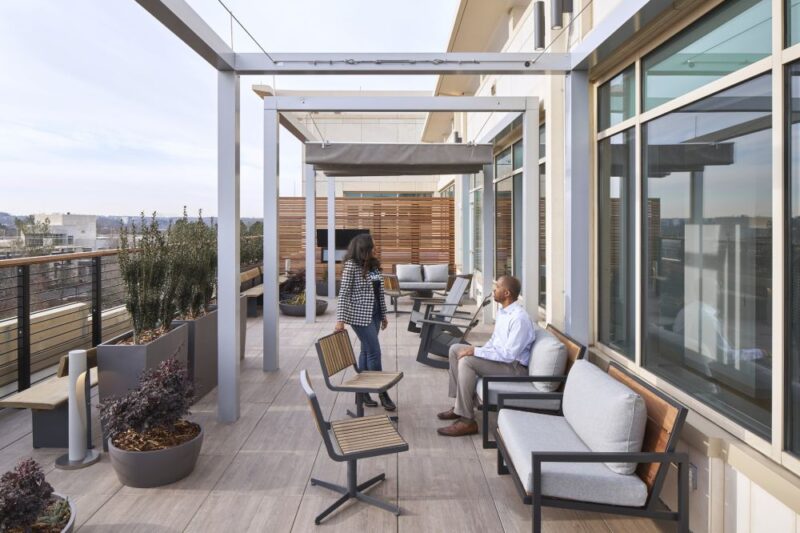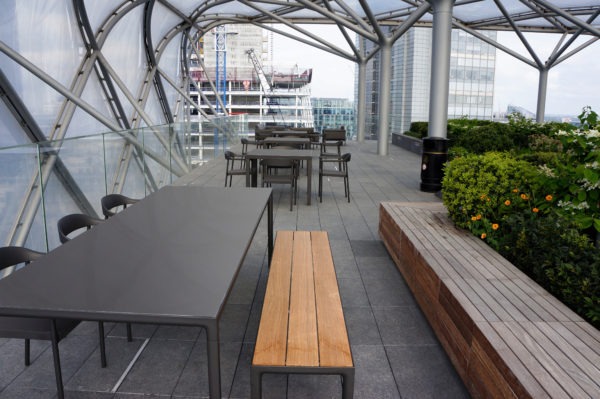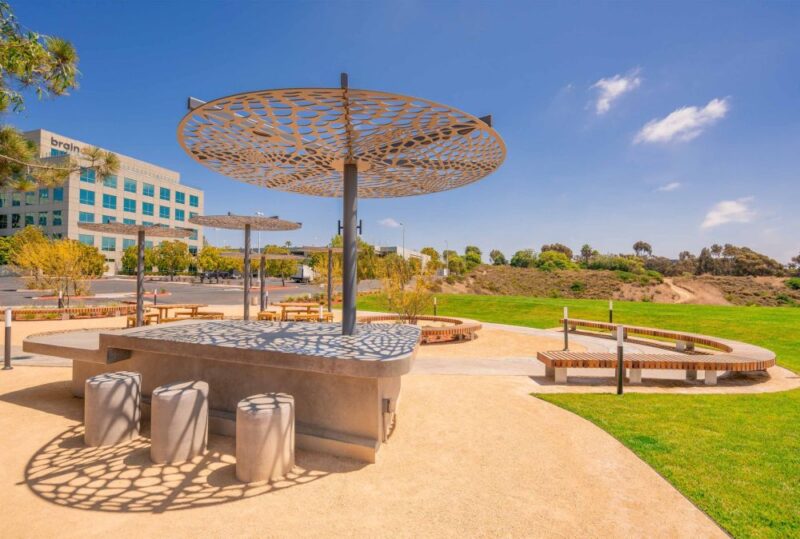Tenant expectations in commercial real estate have shifted dramatically in recent years. Outdoor amenities that once served as attractive extras have now become essential components of modern property design.
Employers and property managers are recognizing the need for spaces that promote well-being, creativity, and productivity.
Post-pandemic work culture emphasized balance and flexibility, and that same mindset has reshaped how commercial developments are planned.
Outdoor spaces now play a crucial role in supporting mental health and fostering a sense of community among tenants.
The New Role of Outdoor Spaces in Commercial Developments

Modern commercial developments are redefining how outdoor areas function within office and mixed-use environments.
Open-air spaces no longer serve as decorative additions but have transformed into essential components of daily operations.
Outdoor areas now integrate seamlessly into the property’s daily rhythm. Courtyards and terraces host meetings, impromptu discussions, and even after-work events.
Many companies use these areas to support flexible work models, reflecting a growing trend toward hybrid operations that prioritize employee experience.
To illustrate the variety of outdoor features contributing to modern commercial success, consider the following:
- Outdoor seating and Wi-Fi-equipped spaces designed for brainstorming or informal meetings.
- Walking paths, fitness zones, or outdoor cafés that promote active breaks.
- Flexible designs adaptable for tenant gatherings and networking events.
- Ponds, fountains, and shaded greenery that improve both aesthetics and air quality.
Access to green surroundings, fresh air, and naturally maintained ponds or fountains has become a defining feature of high-quality workspace design.
Strategic Advantages of Outdoor Amenities

Outdoor amenities are more than visual enhancements; they serve as powerful tools that increase tenant satisfaction, strengthen property value, and support long-term retention.
Developers have recognized that these features deliver both experiential and financial benefits, positioning properties ahead in competitive markets.
Enhancing Tenant Experience
Outdoor courtyards, terraces, and gardens extend the conventional indoor workspace by offering areas for relaxation and inspiration.
Tenants can use them to recharge during breaks, engage in outdoor collaboration, or simply enjoy natural scenery during the workday.
Studies consistently show that access to greenery and sunlight leads to better focus, reduced fatigue, and greater job satisfaction.
Well-curated designs can also reflect a tenant’s corporate identity, reinforcing brand culture through colors, materials, and ecological practices.
For example:
- Sustainability-focused companies might prefer native vegetation and low-maintenance irrigation systems.
- Creative industries may emphasize artistic landscaping and multifunctional spaces.
- Tech-driven organizations often invest in modern amenities with strong connectivity and ergonomic outdoor furniture.
Water features play a key role in creating inviting atmospheres.
Systems such as Admiral pond fountain systems maintain balance and water clarity, ensuring that ponds and fountains remain both functional and visually impressive year-round.
Tenant Retention and Lease Renewals

Investing in outdoor amenities directly impacts tenant loyalty and lease renewal rates.
When tenants have access to well-designed outdoor spaces, they tend to form stronger emotional connections to their workplaces.
That connection encourages them to extend their leases and build long-term relationships with property managers.
Several factors contribute to stronger retention:
- Enhanced comfort and well-being promote daily satisfaction.
- Community-driven spaces support collaboration among tenants.
- Event-ready environments allow companies to host on-site gatherings with minimal external arrangements.
Buildings featuring tranquil courtyards, shaded sitting areas, and water installations often achieve higher occupancy stability.
A single investment in outdoor design frequently yields returns in both tenant happiness and reduced vacancy rates.
Attracting High-Quality Tenants Through Design
Modern commercial leasing has shifted toward lifestyle-driven decision-making.
Prospective tenants now evaluate a property by the quality of its amenities and overall atmosphere.
Outdoor spaces often serve as the deciding factor for companies seeking to attract and retain talent.
Design elements that draw high-quality tenants typically include:
- Rooftop terraces for networking or social events.
- Lush courtyards offering quiet reflection spaces.
- Outdoor lounges for informal meetings and client receptions.
Integrated greenery and water features that project sophistication and environmental awareness.
Biophilic design, focused on reconnecting people with nature, has become a strong differentiator in commercial projects.
Natural materials, flowing water, and organic patterns evoke calmness and improve workplace wellness.
Such thoughtful outdoor integration signals innovation and attention to tenant well-being, especially valued by forward-thinking and tech-oriented companies.
Measurable Financial Benefits

Outdoor amenities are not just aesthetic investments; they provide measurable returns in both revenue and operational efficiency.
Buildings with well-planned outdoor environments regularly achieve higher rent premiums and occupancy rates compared to properties that lack them.
Several financial advantages include:
- Increased rental income due to greater tenant demand.
- Lower turnover costs thanks to longer lease commitments.
- Reduced maintenance expenses through sustainable landscaping choices.
Sustainability is also a major cost-saving factor. Efficient designs utilizing native plants and intelligent irrigation lower long-term water use.
Wellness and Sustainability: The Dual Imperative
Modern real estate success depends on a balanced approach that serves both human wellness and environmental sustainability.
Outdoor areas support physical and mental health by allowing occupants to enjoy natural light, exercise, and social interaction.
At the same time, they demonstrate environmental accountability through efficient design and resource conservation.
Essential practices that combine these objectives include:
- Use of drought-tolerant plants to minimize water consumption.
- Energy-efficient lighting that reduces power use during evening hours.
- Recycled and natural materials for benches, decks, and pathways.
Each feature contributes to environmental stewardship while enhancing tenant satisfaction.
Such integration aligns perfectly with ESG priorities and reinforces a property’s reputation as both health-conscious and eco-friendly.
Data-Driven Design and Management

Developers increasingly rely on data analytics to fine-tune outdoor amenities.
Insights gathered through surveys, occupancy sensors, and usage tracking reveal how tenants interact with outdoor spaces and what features deliver the most value.
Information-driven planning helps ensure that every addition to a property serves a defined purpose.
Key elements of successful data-driven management include:
- Tracking how frequently certain areas are occupied.
- Regular tenant surveys to adjust amenities to changing needs.
- Measuring performance in terms of satisfaction and leasing success.
Collaborating with expert partners ensures consistent maintenance and design innovation. Landscape architects, property managers, and environmental engineers work together to maintain quality and adapt to evolving tenant expectations.
Proper partnerships also ensure that outdoor areas remain cost-efficient, functional, and aligned with long-term business objectives.
The Bottom Line
Outdoor amenities have become non-negotiable features in commercial real estate.
They are no longer seen as luxuries but as vital components that drive tenant satisfaction, productivity, and long-term retention.
Properties that prioritize wellness, sustainability, and data-backed design gain measurable advantages in both performance and perception.
In commercial real estate today, outdoor environments are not optional enhancements but essential investments in a thriving business ecosystem.

